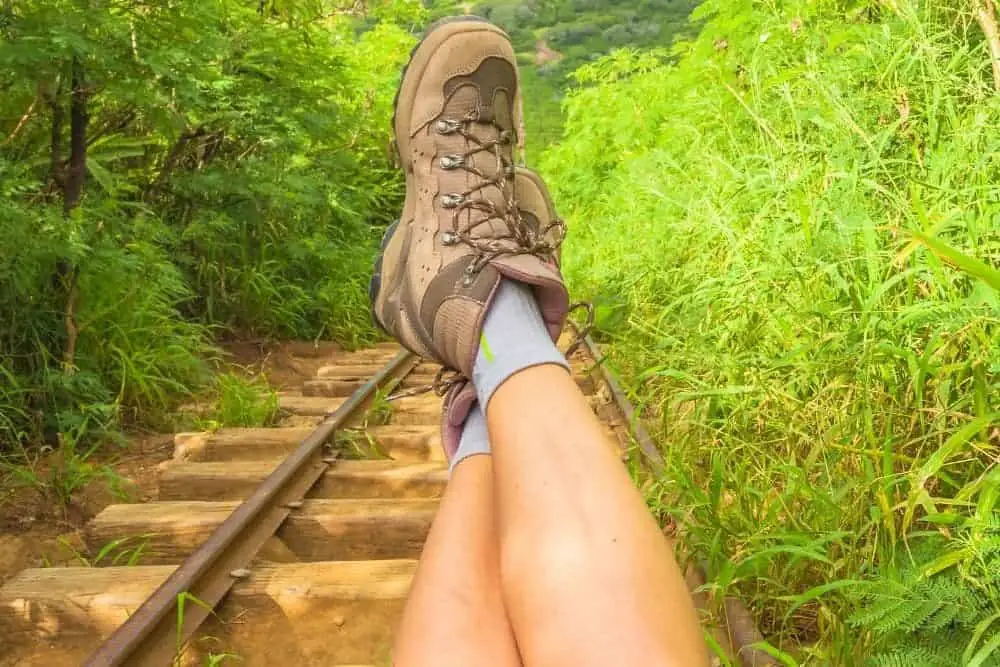You might probably be as excited as we were to hike in Hawaii, and your mind is already wondering what’s essential and what isn’t. Well, for starters, for every hike in Hawaii, hikers frequently ask, “Do I need hiking boots for Hawaii?”
Personally, what you wear while hiking in Hawaii plays a significant role in determining how much fun it would be for you. So, if you are hesitant about wearing hiking boots in Hawaii, we will guide you on the right path to make your hike a success.
In the course of this article, we will answer one of the most frequently asked questions by hikers in Hawaii. Additionally, we will offer you a guide on making the perfect hiking boots selection for hikes in Hawaii.
Nevertheless, before we proceed, let’s see some fantastic features of Hawaii. There we would discuss the terrains, natural conditions, weather patterns, and animal presence while hiking in Hawaii. So, let’s begin!
Contents
Hawaii | The Complete Breakdown
Now here’s one truth every hiker needs to know before embarking on a hike; you need thorough knowledge about your hiking location.
Trust us, without this knowledge of the geography and conditions of the place; you might end up regretting your hike.
So, what’s it like hiking in Hawaii?
1. Terrain
The truth about Hawaii is that you don’t get the same terrain all through. Some terrains are less bumpy, while others are highly rugged. So first off, if you want to hike at Diamond Head or the Volcano Park in Hawaii, you will meet well-paved terrains.
These terrains are less bumpy or rocky – in fact, you will barely see jagged lava. However, when you decide to move to other hiking trails like the Napali Coast or Waimea Canyon on Kauai, you will get rocky, bumpy, and jagged lava terrains.
In the more popular hike sights in Hawaii like Kalalau Trail, the terrains are wet, bumpy, and sometimes muddy (when it rains). This terrain structure makes it difficult for hikers to move without sturdy hiking boots.
Additionally, the terrains in Hawaii are pretty slippery, especially on ridge hikes. You will often get muddy terrains when hiking in valleys, especially during rainy seasons – they are the toughest.
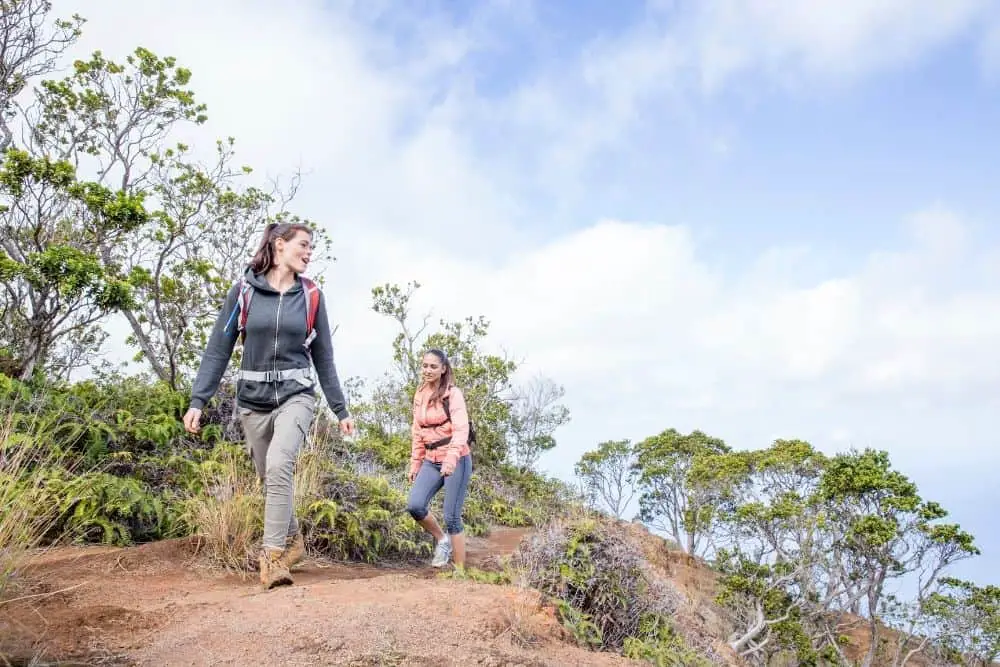
2. Natural Conditions
Let’s face it; Hawaii isn’t your most friendly location for hikes, and it’s pretty obvious. However, you will surely get scenic views from high cliffs and hilltops while hiking in Hawaii.
In Hawaii, one minute, you could be hiking through the jagged lava-infested landscape, and the next, lush buses. Additionally, in Hawaii, you will find thick forests, jagged lava grounds, lush bushes, and waterfalls.
Let’s just say in Hawaii you will find almost everything you would want to see on a hike (landscape-wise). Depending on your location and height while hiking, you will also see captivating streams.
Lastly, while hiking in Hawaii, there’s every chance you will spot volcanic gasses or vog. Vog is a mixture containing sulfur dioxide gas, carbon dioxide, dust, water vapor, and other gases. It mainly occurs when hot lava meets with the sea.

3. Weather
First off, you need to understand that the temperature in Hawaii is primarily hot or warm all year. Therefore, you will get consistent weather conditions in Hawaii, with slight changes in temperature.
In Hawaii, you might want to say there are only two seasons – summer and winter. Nevertheless, in Hawaii, you get to experience all the seasons from spring to autumn, summer, and winter. Our personal favorite time to hike in Hawaii is in the summer (or autumn).
Some information is referred to Seasons of the Year.
Spring
During spring in Hawaii, the temperature and weather conditions are usually pretty pleasant from March to May. You will experience the most rainfall in March, with an average precipitation of about 1.9″ (50mm).
Meanwhile, the average temperature you will experience during this season in the daytime would be 25°C (75°F). However, at night in Hawaii, the temperature can drop to about 19.5°C (67°F).
Nevertheless, you can overcome the cool evenings and nights with long-sleeved sweaters. That is if you would want to hike in Hawaii in the spring.

Summer
This is the actual hot season in Hawaii, which usually spans from late April to August. 287 hours of daylight monthly and an insignificant amount of precipitation.
When hiking on any trail in Hawaii during the summer months, you need to expect warm to hot temperatures in the daytime. For instance, in the daytime, the average temperature is about 30°C (86°F).
Meanwhile, in the evenings or nights, the temperature drops to about 21.5°C (71°F). Generally, the summer months in Hawaii maintain a steady warm temperature during the day with cool evenings.
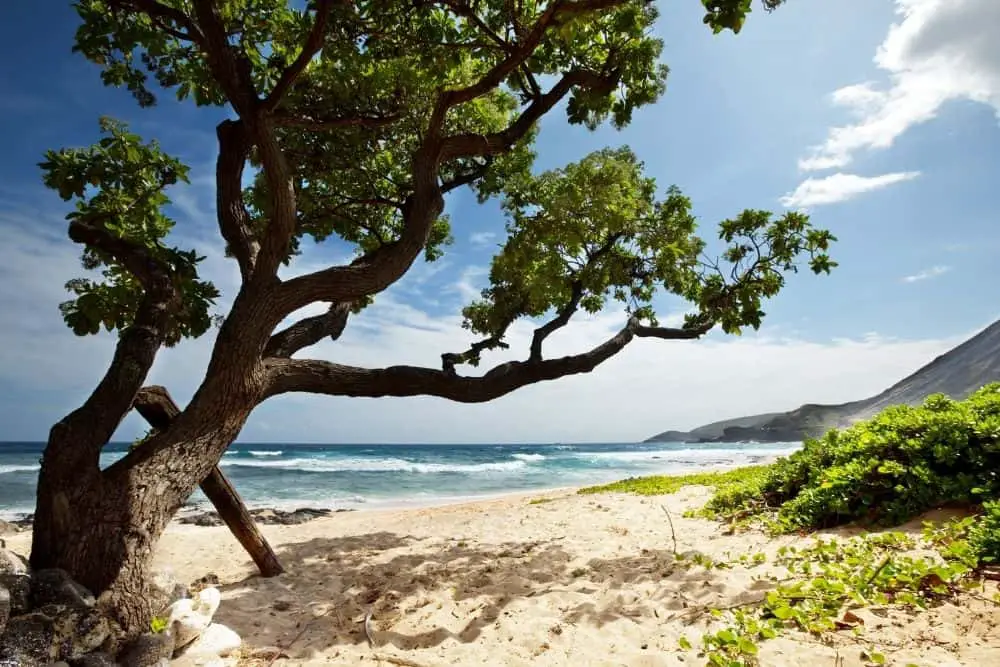
Autumn
You can say the autumn season in Hawaii is just a disguised summertime – in terms of weather. However, in Hawaii, the autumn season usually has increased precipitation and temperature drops.
Averagely, the daytime temperature from September to November is about 30°C (86°F). Whereas at night in Hawaii this month, the lowest temperature would be at 21°C (70°F).
As a hiker hiking in this season, you will need to stay hydrated in the daytime, to cool your body’s temperature. This means packing a lot of water; failure to take enough of it might result in you getting weaker on your hike.

Winter
We know you might probably be expecting freezing temperatures during the winter months in Hawaii, but that’s not the case. As earlier stated, Hawaii is pretty hot and warm, and with a consistent temperature throughout the year.
The precipitation level is mainly highest in December, with it reaching 3.1″ (80mm).
However, from December to February, the average daytime temperature varies from 24°C (72°F) to 22°C (75°F). Whereas in the evenings and nights, the temperature is average at 18°C (65°F).

4. Animals
While hiking in Hawaii, you would see several different animals on land, air, or water. But, primarily, you can refer to Hawaii as home to some endangered species.
Nevertheless, some animals you are likely to see are arthropods (centipedes and cane spiders). Additionally, you will get good glimpses of deadly venomous scorpions.
Some rare animal species you will see in Hawaii include Nene Geese and Honu Turtles. Moreover, you can see these animals close to the beaches from hilltops.
Some information is referred to HAWAII SAFETY & HAZARDS GUIDE.
Do I Need Hiking Boots for Hawaii?
When it comes to needs for hikes in Hawaii, it’s usually always about breathable clothing and footwear because of the warm temperature. However, in terms of “type of footwear,” many hikers get confused.
Regardless, here’s our honest opinion; for hikes in Hawaii, you need hiking boots. Although a lot of people will argue this, hiking boots are simply the best option.
How? Imagine you have to choose between good and best; hiking boots are the latter for Hawaii hikes.
Of course, specific hikes in Hawaii are easy with well-paved and graded trails; however, that’s few compared to the many rough ones.
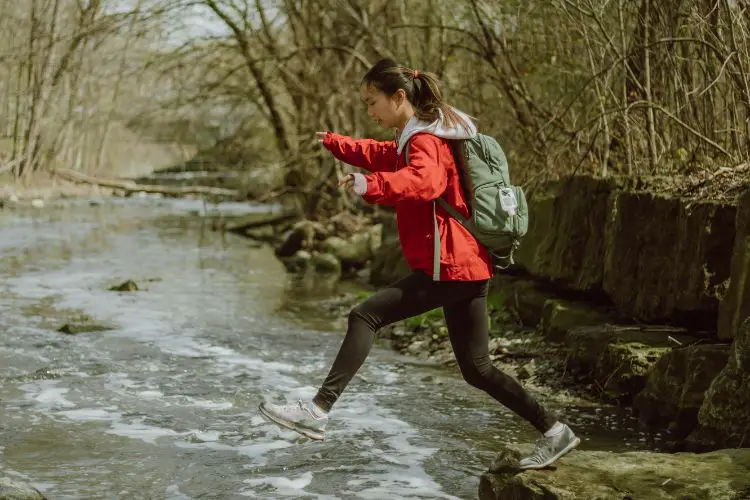
Nevertheless, some hikers tend to use running or sports shoes for hikes on trails like Diamond Head in Hawaii. While this might work for some trails, it wouldn’t for a more significant number of others.
So, although it might seem like hiking boots weigh more than your traditional shoes, they are just the better choice.
First off, the traction on hiking boots is second to none! The trails in Hawaii can be pretty slippery, even without the rain. And slipping isn’t something you want while hiking, because you could fall and get badly injured.
Can you use other footwear for easier hikes in Hawaii? Yes.
Do you need hiking boots for Hawaii? Yes.
Are hiking boots the best option for hiking in Hawaii? Yes.
Do we advise you to use other footwear for hikes in Hawaii? No.
Perfect Features of Hiking Boots for Hawaii
There are some features possessed by hiking boots that make them stand out from other footwear.
These features make them excellent choices for hiking in Hawaii when you consider the terrain and weather conditions.
1. Non-Slip Outsoles
This is one of the features of placing hiking boots ahead of other footwear for hikes in Hawaii. If you didn’t know, Hawaii’s terrain could be pretty slippery, even when it isn’t raining.
This slippery nature of Hawaii is due to the geology of the terrain. Trust us; when you try cross-rooted sections in Hawaii, you will often find yourself slipping easily.
The traction (or slip resistance) provided in hiking boots makes them excellent grippers for Hawaii grounds. Whether you are hiking over jagged lava, dry-graded gravel, cross-rooted sections, or wet terrains, the outsoles on the hiker’s boots offer the best grip.
The reason for this excellent traction in hiking boots is due to the provided rubber and tread patterns on the outsoles.
The rubber outsoles either come from brown or carbon designs, which have increased hardness and slip resistance. Then the tread patterns provide friction for all surfaces.

2. Waterproof Lining
Hiking in Hawaii can be pretty exciting and fun; however, things start going south when it begins to rain. For instance, in the spring and winter, you will experience high precipitation.
Now, if your hiking boots lack proper waterproofing, there are increased chances of you getting foot-related problems.
The dangers of soaked or wet feet while hiking isn’t an over-exaggeration; it will leave your foot with different smells and damages.
Additionally, the valleys in Hawaii can become pretty muddy in wet conditions. This will cause your feet to soak without proper waterproofing.
Hiking boots are the top recommendable footwear that can withstand the wet conditions of Hawaii – giving you the perfect hike.
3. Insole, Shanks, and Plates
Many people will argue that other shoes offer better comfort than hiking boots. Well, here’s our take. Although there might be a slight truth, hiking boots provide the best comfort for hikes in Hawaii.
Generally, the terrains are jagged, bumpy, and rocky, and will utterly cause you to lose your balance at some point. But, with hiking boots, you can easily overcome the mentioned challenges posed by Hawaii trails.
With the type of midsoles and interior designs of hiking boots, you can be sure of top-notch comfort. For instance, most hiking boots come with EVA or PU-type midsoles which are excellent comfort providers on all terrain.
Then, you have the in-built shanks and plates in hiking boots. This design ensures stability to your stance, even on uneven surfaces.
The shanks and plates lie between the midsole and outsoles, absorbing all external shocks to the feet and creating stability.

4. Toe Caps and High Collar
Honestly, the protection provided on hiking boots is perfect for hikes in Hawaii. As you know, the jagged lava grounds can be bumpy, and the rocky terrains can be harsh on the feet while hiking in Hawaii.
Additionally, even while hiking on the easy trails in Hawaii, you will often find tree roots all over the place. Colliding with any of these obstacles will damage your foot; for example, toenail breaking.
For this reason, the protective composite or rubber toe caps provided in hiking boots help to keep your feet safe. In addition, this toe cap reduces the impact of collisions on your feet, thereby preventing bruises or injuries.
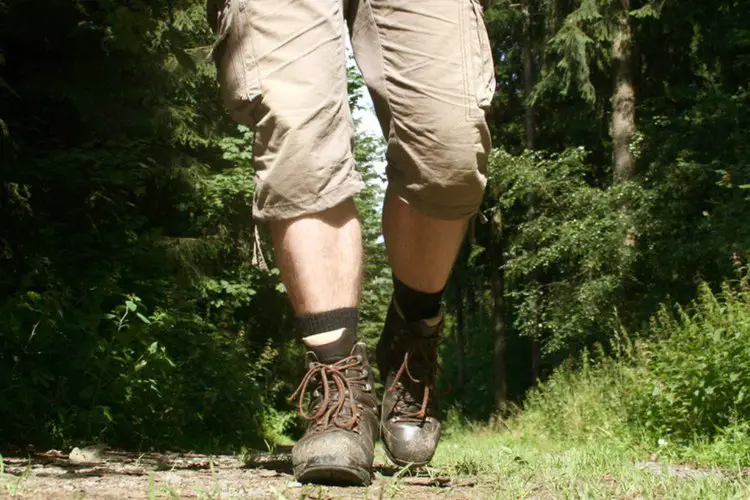
Then, the shaft height in most hiking boots is mid to high. This feature serves as a protection for your lower limb as it prevents bites from venomous crawling animals in Hawaii. Also, you can safely pass through thorny lush bushes without getting scratched.
5. Breathability
Generally, as earlier stated, the temperature in Hawaii is pretty hot or warm throughout the year, making hiking boots’ breathability a plus.
Generally, sweaty feet are one of the leading foot problems of hikers. The reason for several sweaty feet is due to the poor breathability of some footwear. However, hiking boots possess a highly breathable membrane design.
This design allows the wicking of sweat (or moisture) from the inside of the hiking boot to the outside. Hiking boots gain this breathability due to the leather and mesh material designs they possess.
6. Solid Construction
Let’s face it; your running or sports shoes won’t offer you good durability like hiking boots. Sure, these shoes might be pretty durable when used for other activities, but once it involve hiking, they will fail.
The durability of hiking boots is one of the best for hikes in Hawaii. Unlike other footwear, the outsoles in hiking boots will not pull off easily, nor does its built leather, synthetic, or mesh design tear quickly.
The reason for the heavy durability of hiking boots is traceable. Firstly, their upper parts have durable leather, synthetic, or mesh design. Then, the outsoles in hiking boots come from high-carbon rubber designs with superior stitching to join them.

7. Weight
If you have ever tried hiking with any other boots, the moment you try on the hiker’s footwear, you can instantly tell the difference. First off, we can confirm that whatever boot you used previously weighed much more than the hiker’s footwear.
Generally, hiking boots are famous for their lightweight design. This lightweight feature helps hikers to move over Hawaii trails easily and quickly when climbing steep terrains or hilltops. Of course, some other footwear are lighter than hiking boots, but they will not possess some specific features.
The good thing about hiking boots is that they come with numerous excellent features and they remain lightweight. Whereas, other boots will pack the same features (or less) and be heavy on the feet.
Poor Features of Hiking Boots for Hawaii
Get this; hiking boots are the perfect pick for Hawaii trails, but sometimes they can be pretty questionable. These poor features bring disputes about the need for hiking boots.
Nevertheless, these features do not displace the need for these boots.
The poor features of hiking boots for Hawaii include;
1. Long Break-In Time
Honestly, we find this exhausting about hiking boots. They are pretty rigid and stiff, which can be great for ankle support, but it utterly affects the break-in time.
If you buy hiking boots to hike on any trail in Hawaii, there’s a big chance you might choose one with a long break-in time. Sure, there are hiking boots without the prolonged break-in period, but they are few.
What this prolonged break-in time does to the feet when hiking in Hawaii is to cause unneeded blisters and bruises. This can be pretty bad and will affect the entire excitement your hike should bring.
Nevertheless, we suggest you get hiking boots without this long break-in time. Otherwise, you risk wounds, bruises, and blisters to your feet.
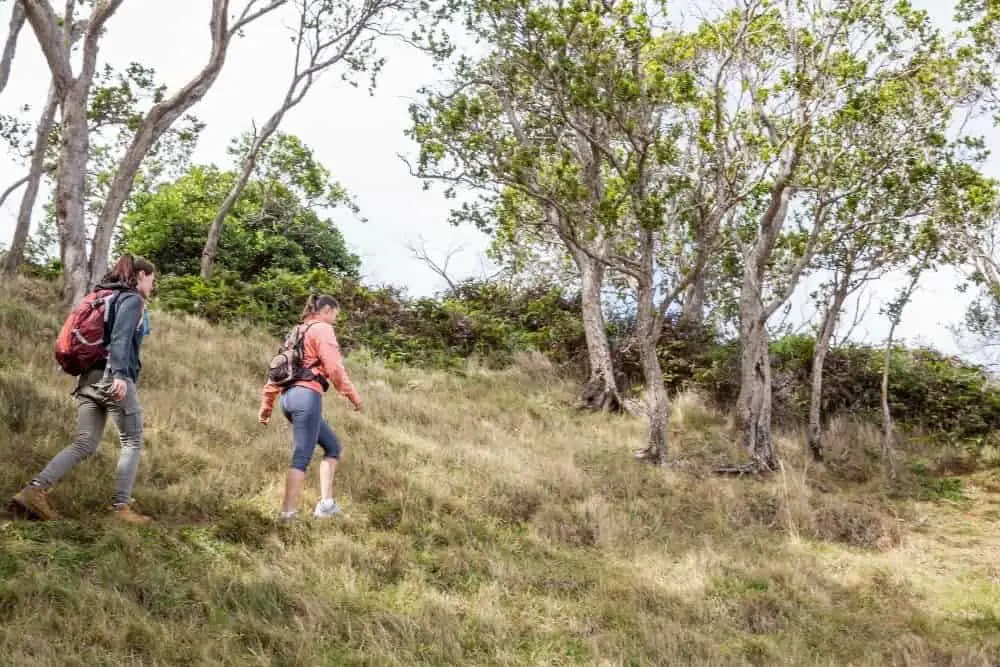
2. Rigid Outsole
We know we had earlier praised hiking boots for the superb traction and stability brought by the outsoles; there are some slight disadvantages to them.
Firstly, the outsoles are pretty rigid, hard, and thick and make feeling the ground impossible.
Now, when your feet cannot sense the ground it is on, you are likely to trip over and fall. Although traction and grip of the outsole will (to some extent) keep you from falling, your body weight might still overcome it.
Generally, you sometimes can’t feel the ground while wearing hiking boots. Thereby creating high chances of sticking your feet in between rocky terrains or lava floors without knowing – which can result in ankle twisting.
Nevertheless, if you can always watch your steppings while hiking in Hawaii, we know you can overcome this poor feature.
Features | Editor’s rating |
| Comfort | ⭐⭐⭐⭐⭐ |
| Protection | ⭐⭐⭐⭐ |
| Flexibility | ⭐⭐⭐⭐⭐ |
| Waterproofness | ⭐⭐⭐⭐ |
| Durability | ⭐⭐⭐⭐ |
How to Choose Hiking Boots for Hawaii?
We understand planning a hiking trip to Hawaii can seem pretty exciting, and we are here to make it the best for you.
Moreover, choosing the perfect hiking boot can be utterly challenging for anyone. And for this reason, we will give a guide that will make your selection much easier.
So, what are the features to watch out for when choosing hiking boots for Hawaii?
1. Slip Resistance
Judging from the terrains of Hawaii, you would agree with us that hiking boots with top-notch slip resistance are essential. Unfortunately, the terrains on some trails in Hawaii have proven highly slippery, which can be utterly dangerous.
Personally, hiking boots offering the best slip resistance (or traction) for Hawaii terrains are the ones with rubber outsoles. There are primarily two types of rubber outsole used to design hiking boots; brown and carbon.
Now, the rubber outsoles do not provide traction on hiking boots alone. In fact, the tread patterns (designs underneath the boot) and the deep grooves play a significant role in improving friction and traction. So, look for hiking boots that have deep groves and several tread patterns.
Nevertheless, the type of rubber outsole you should be looking to have in your hiking boot is carbon. Why? The carbon rubber outsole is strong, durable, and has higher slip resistance on wet surfaces than brown.

2. Breathability
What is breathability? This refers to your hiking boot’s ability to allow airflow in and around your footwear. Furthermore, it also refers to your boot’s nature being able to “wick” moisture (like sweat) from your feet to the outside.
The temperature in Hawaii is pretty hot, and this will lead to constant foot sweating. Therefore, you need to have the best breathable hiking boots you can get, or you might suffer from sweaty feet.
The best breathable hiking boots have mesh, textile or nubuck leather material designs.
Moreover, some hiking boots have a combination of both materials, increasing breathability. Furthermore, the presence of eyelets and vented holes, thin collars, and moisture-wicking insole increases hiking boots’ breathability.
- DURABLE & PROTECTIVE - This mens hiking boots upper made of suede leather with 1000D Cordura fabric,...
- BREATHABLE & COMFORTABLE - Thinner fabric and vented holes in the collar made this summer work boots...
- LIGHTWEIGHT & FIT - This lightweight work boots made with US size, fit !!! If you are hesitate to...
Last update on 2023-11-11 / Affiliate links / Images from Amazon Product Advertising API
3. Waterproof Upper
Whether it’s spring or not, you will often get some level of precipitation in Hawaii. Once this begins to happen, if you are not wearing hiking boots made with waterproof uppers, there is a high chance of getting your feet soaked.
What waterproof hiking boots would do is prevent water or other liquids from passing through the material. So for you to spot the best waterproof hiking boot, it would be the one having Gore-Tex lining designs.
Additionally, the construction of the material in the upper usually has a leather or synthetic build. Now, the choice of leather could be full-grain, split-grain, or nubuck. But, preferably, we would choose the full-grain leather material as the best waterproofing material.

4. Weight
Let’s face it; going on hikes on the difficult Hawaii trails can be challenging. You wouldn’t want to increase that challenge by adding unneeded extra weight.
Generally, hiking boots are already pretty lightweight, but some weigh more than others. Personally, the most suitable hiking boots for hikes in Hawaii are the lightweight ones.
We suggest that you go hiking boots weighing nothing more than 3 lbs and a few ounces. You wouldn’t want your hiking boot too light because it would lack some features.
Also, you wouldn’t want it heavy because it would make your hike uncomfortable. The reason for the lightweight nature of hiking boots is due to the lack of some features like insulation.
Although there are some hiking boots with insulation, there aren’t many of them.
5. Comfort and Cushioning
In this part, let’s talk about the midsole, comfort, and all the interior components supplying cushioning. This cushioning refers to all the added interior designs that make you feel comfortable even on rough terrains.
For starters, the midsole separates the feet from the outsole and brings about a lot of comfort. The most comfortable midsoles are EVA and PU, and that’s why we advise every hiker to get hiking boots with either one.
Then, for more comfort, your hiking boots should have some soft interior lining. It can be by the sides, above your feet, or a combination of both.

6. Stability and Ankle Support
Hiking on the trails of Hawaii means that you will experience uneven grounds and rough and jagged terrains. You would want perfect stability and ankle support for all your hikes, which hiking boots provide.
Firstly, you would want to ensure your hiking boot has steel plates and shanks for stability. This absorbs shock, and keeps you balanced and standing even on rough terrains. Personally, it is a vital feature to have in your hiking boots when in Hawaii.
Then, ankle support is a necessity, especially when on any difficult trail in Hawaii. Imagine stepping between rocks and bumpy grounds – without proper stiff and soft support, you might end up twisting or dislocating your ankle.
7. Protection and Durability
Protection of your feet during hikes in Hawaii doesn’t refer only to toe caps; the outsole and upper designs all play significant protective roles.
Nevertheless, protecting the front part of your feet is essential. Therefore, we would advise that you go for hiking boots having either composite or rubber toe caps.
These caps will reduce or stop all impacts from colliding with force in the front of your hiking boot.
Furthermore, your boots’ durability should always be a priority.
The way to achieve this high durability in your boot is by noticing the type of material used in its designs: leather and synthetic materials coupled with a carbon rubber outsole showcase a durable hiking boot.

Notes for Hikers in Hawaii
For you to be reading this article, it means you have plans on hiking in Hawaii. Well, how about giving you a few noteworthy pieces of advice that will make your trip better?
Let’s see some of the things to note before going on hikes in Hawaii.
- Never hike alone – go in groups of three or more.
- Don’t swim in every stream or pool. In Hawaii, some of the streams or pools harbor dangerous infectious bacteria like leptospirosis.
- Remove all valuables from your car – if you parked it at a remote location.
- Stop hiking once it begins to get dark; it’s safer for you and your group.
- Remember to take along hiking essentials for Hawaii. These essentials include;
- Water – lots of it.
- Food, snacks, and eatables.
- Sunscreen.
- Windbreaker.
- Hiking poles.
- Hiking boots (of course)!
- First aid kit.
- Whistle.
What to Wear for Hiking in Hawaii?
The “wear” for hikes in Hawaii can be pretty preferential between hikers. However, since the weather conditions are pretty warm throughout the year in Hawaii, we’d suggest you take along breathable clothing.
Primarily, T-shirts or tank tops will do just fine for hikes in Hawaii. In fact, they will mainly serve as protection from the ultraviolet rays of the sun.
Then, shorts or leggings with hiking boots will be a perfect blend. Nevertheless, if you plan on hiking longer trails (meaning, you will meet evenings while on a hike), we’d suggest you go with jackets for the cool nights.
Is Hiking in Hawaii Safe?
Generally, no hiking sight is 100% safe, and that’s pretty much the truth. However, you can mitigate the risks and provide safety – by sticking to the rules.
If you follow the set rules governing hikes in Hawaii, you can be sure of a safe hike. Not only that, as a hiker, you need to know your limits and capabilities.
Go for trails in Hawaii like Diamond Head that are less difficult to move over. If you are still a, to keep things safe, choose trails that would allow you to move easily and quickly.
Do I Need Hiking Boots in Oahu?
The trails in Oahu are not the most rugged or rough in Hawaii. Although hiking boots remain the perfect option to combat slippery terrains and bumps in Oahu, other footwear like hiking or trail running shoes can get the job done.
Do you need hiking boots in Oahu? No, as it is one of those less difficult hiking trails in Hawaii. Nevertheless, if you want to be on the safe side, you can still opt for hiking boots.
Do I Need Hiking Boots for Maui?
Personally, wearing hiking boots for hikes in Maui seems too much. Sure, it will provide the best waterproofness and traction, but so will other footwear.
For example, running or tennis shoes might seem like an appropriate option since they are more lightweight.
Top 3 Hiking Boots for Hawaii
Hawaii can be hot and challenging. For starters, you would be hiking over lava, wet, and bumpy grounds, posing its challenges.
Nevertheless, we gave a guide on how to choose the perfect hiking boots for Hawaii. Now, we have decided to bring our top three picks that would serve you best while hiking in Hawaii.
1. Merrell Alverstone Hiking Boot
- GORE-TEX waterproof membrane, exceptional breathability and waterproof performance
- Suede leather and mesh upper
- Traditional lace closure
Last update on 2023-11-10 / Affiliate links / Images from Amazon Product Advertising API
The Merrell Alverstone hiking boot is a fully leather and textile design hiker’s footwear. This boot from Merrell comes with a unique in-built cushioning Kinetic fit footbed that brings maximum comfort and support to your feet.
Additionally, the high shock-absorbing feature of this Merrell Alverstone makes it a fan favorite for hikes. This feature allows the hiker to feel more balanced and comfortable in the Merrell Alverstone hiking boot.

Also, should you step on uneven surfaces, the stability from Merrell’s air cushion will prevent sudden falls. Furthermore, most users have commended Merrell for the superior traction they get on all the slippery surfaces in Hawaii. And this is due to its tread patterns and rubber outsoles.
However, the durability of this Merrell Alverstone isn’t the best. Nevertheless, it remains an excellent buy, as its leather and textile designs add to the lining giving it waterproofing features for the wet seasons in Hawaii.
Pros
- It comes with 100% leather and textile material.
- High shock-absorbing property and stability.
- Kinetic fit contoured footbed.
- Superior waterproof hiking boot.
- It sports rubber outsole designs for maximum traction.
Con
- Users complain that the boot’s durability begins to fade after some time.
2. RockRooster Hiking Boot
- 【HYDROGUARD Waterproof Membrane】Waterproof Membrane System, Slip-Resistant.
- 【Non-slip Rubber Outsole】Slip-Resistant, Slip and Oil Resistant Rockrooster Rubber Outsole
- 【CoolMAX, Quick Dry】Fabric made with COOLMAX technology transports moisture away from the body...
Last update on 2023-11-10 / Affiliate links / Images from Amazon Product Advertising API
The RockRooster hiking boot is the hiker’s footwear coming with 100% oiled nubuck leather, giving it high durability.
In addition, the non-slip rubber outsole and tread patterns in this RockRooster hiking boot play a significant role in providing traction for slippery surfaces in Hawaii.

For all the rainy seasons and wet surfaces in Hawaii, RockRooster has added its hydroguard waterproof membrane to prevent water penetration into the boot.
As a plus, you will find this RockRooster hiking boot essential for Hawaii due to the breathable CoolMax technology.
Furthermore, this boot from RockRooster is pretty comfortable with the added anti-fatigue memory insole, as it reduces foot soreness and pains.
However, the RockRooster hiking boot isn’t the lightest footwear. You might find its weight quite high; other than that, it’s an excellent buy.
Pros
- Features 100% oiled nubuck leather.
- It comes with a non-slip rubber outsole for ultimate traction.
- Hydroguard waterproof membrane for wet conditions.
- Highly breathable with CoolMax quick-dry technology.
- Anti-fatigue memory insole foam for maximum comfort.
Con
- Some users have raised complaints about the slightly heavy weight of the boot.
3. Wantdo Hiking Boot
- Waterproof--The men's hiking boots features durable textile and TPU upper,could effectively prevent...
- Slip-resistant--This non slip tactical boots with 6mm deep (Vibram) outsole provides excellent...
- Durability--The waterproof work boots for men has rugged Vibram rubber outsole, which could provide...
Last update on 2023-11-10 / Affiliate links / Images from Amazon Product Advertising API
The Wantdo hiking boot comes with a mesh and leather material design. In addition, this Wantdo hiking boot sports the Vibram-type rubber outsole, which provides excellent traction on slippery surfaces like Hawaii’s.
Furthermore, for comfort while hiking in Hawaii, Wantdo has added the EVA-type midsole for consistent comfortability.
With this boot from Wantdo, you get a 5-inch shaft height which offers ankle support and protection from branches of lush bushes in Hawaii.

In addition, for your toe and forefoot protection, Wantdo placed rubber toe caps in the front of this boot. This will help to reduce heavy collision impacts to the feet.
However, the waterproofness of this boot isn’t the best. In fact, some users have scored this feature below average. Nevertheless, the excellent features in this Wantdo hiking boot, like arch support, make up for this lapse.
Pros
- Vibram rubber outsole gives excellent traction.
- High 5 inches shaft height offering ankle support and protection.
- Highly comfortable EVA midsole designs.
- Presence of rubber toe caps to prevent heavy impacts on feet.
- Appropriate arch support.
Con
- Many people have complained that the provided waterproofness is subpar.
Conclusion
As a hiker going to Hawaii, you need to take into consideration the essential and unimportant things.
For starters, it would help if you cared about your feet as they are the primary movers in your hike.
In this article, we have highlighted the need for hiking boots for hikes in Hawaii. In addition, we also stated the features of hiking boots that make them perfect for hikes in Hawaii.
So, when you want to hike in Hawaii, consider referring to this article for all the necessary tips.

